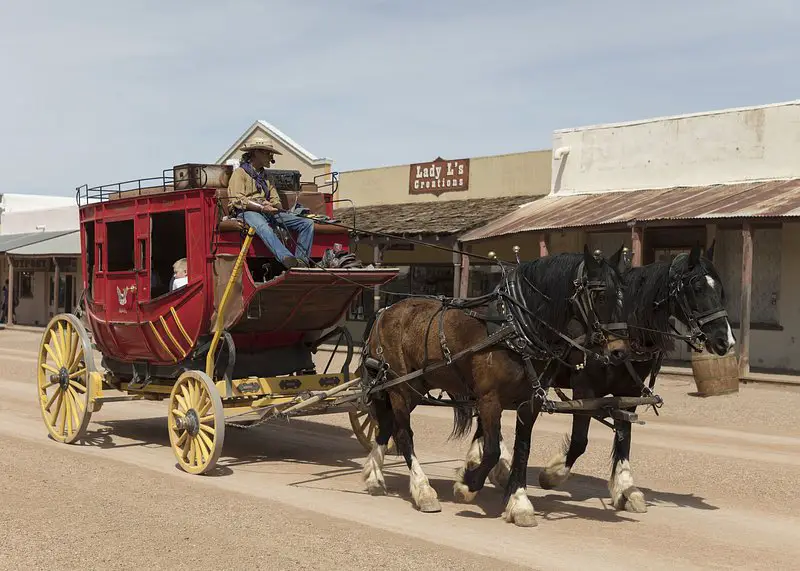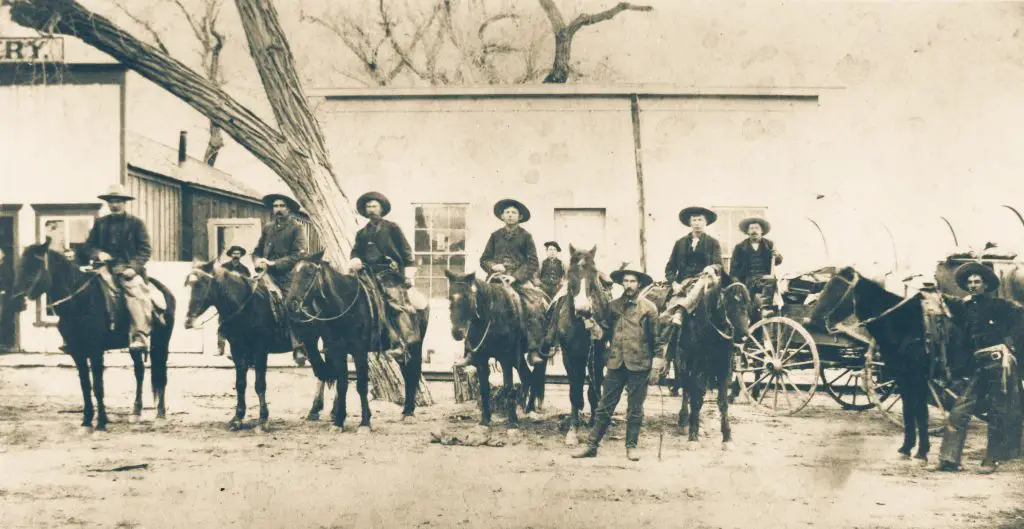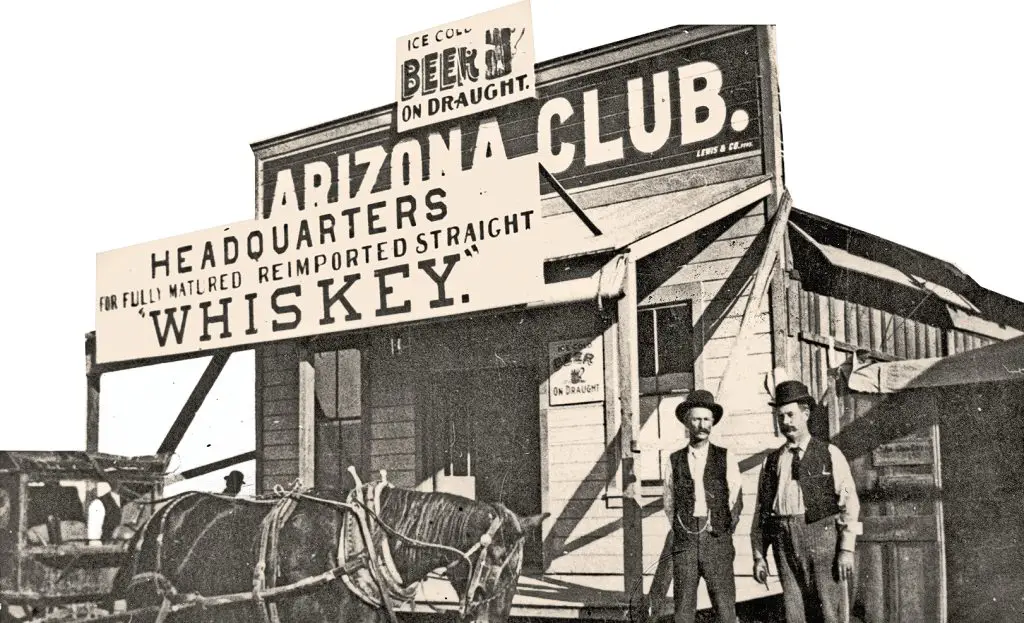Prescott’s Old West history is not just a part of a bygone era; it’s a vivid tapestry woven with daring adventurers, gritty pioneers, and the ceaseless pursuit of dreams. It’s where legends were born, and history was made.

Within the realms of this historical era, you’ll discover interesting trivia that sheds light on the very soul of the American frontier. This article delves into the intriguing aspects of Prescott’s past, from its early days to its influence on modern culture.
The Early Days of Prescott
The early days of Prescott, Arizona, are characterized by exploration, settlement, and the establishment of the community. Founded in 1864, Prescott’s early history involves the native tribes, explorers, and pioneers who first inhabited the area.
The naming of the town after historian William Hickling Prescott and the selection of Prescott as the Territorial Capital were defining moments in these formative years. Key events like the Treaty of 1868 with the Yavapai and the construction of Fort Whipple shaped the relationships and growth of the region.
The Sharlot Hall Museum and other historic sites offer a window into this foundational era, preserving the essence of Prescott’s intriguing beginnings.
Founding and Settlement: The Pioneers Who Built a Town
The initial settlement of Prescott was marked by hardships and determination. The pioneers who braved the unknown faced challenges such as hostile environments and the constant threat of attack. Yet, they persevered, building a community that would become a thriving hub in Arizona Territory.
The town was officially founded in 1864, becoming the first territorial capital of Arizona. Sharlot Hall Museum in Prescott holds an extensive collection of artifacts and documents that recount these early days. This museum stands as a testament to the enduring spirit of those early settlers.
Important Early Figures
The early years of Prescott were shaped by several influential individuals. Governor John Goodwin was instrumental in selecting Prescott as the territorial capital. His leadership and vision laid the groundwork for the town’s growth.
Another key figure was William Hickling Prescott, a renowned historian for whom the town was named. His works, including “The Conquest of Mexico,” were admired by the settlers, and his name became synonymous with the community.
Through the efforts of these individuals and many others, Prescott grew from a small settlement into a bustling town. Their stories remain etched in the town’s history, available for exploration at places like the Prescott Public Library.
Gold Rush Era
Prescott’s Gold Rush Era marked a transformative period in the town’s history, as the discovery of gold in the 1860s led to a rapid influx of fortune-seekers, adventurers, and entrepreneurs. This era defined the economic landscape, creating both prosperity and challenges for the emerging community.

The development of mining technology, the establishment of Prescott as a capital, and the social dynamics of the mining camps all played a crucial role in shaping the town’s identity. Key landmarks like Lynx Creek and the Sharlot Hall Museum continue to tell the story of this pivotal time, reflecting the excitement and complexities of Prescott’s Gold Rush Era.
Discovery of Gold: The Spark That Ignited Growth
In 1863, gold was discovered in the vicinity of Prescott. This discovery ignited a frenzy of activity as prospectors rushed to the area in search of riches. The gold rush significantly contributed to the development of Prescott and the surrounding regions.
Major mines like Lynx Creek were established, leading to a boom in both population and economic growth. The Arizona Geological Survey provides detailed information on the gold mining history of Prescott, offering insights into the methods, challenges, and successes of those early prospectors.
Key Mines and Operations: Lynx Creek, Big Bug Mine, and Walker district
Economic and Social Changes: Boom in population, the emergence of new businesses, and social diversification
Prescott’s Notorious Outlaws and Lawmen
The gold rush wasn’t just about fortune; it also attracted a fair share of criminal elements. Some of Prescott’s most notorious outlaws have become legendary figures.
The names like ‘Bucky’ O’Neill, a sheriff who brought law and order to the city, and Augustine Chacon, a feared bandit, still echo in the annals of Prescott’s history. The confrontations between the lawmen and outlaws were fierce and sometimes deadly, and their tales have been passed down through generations.
You can explore these intriguing characters further at the Phippen Museum, which showcases Western art and history. The stories of the outlaws and the lawmen who pursued them are part of the rich fabric that makes Prescott’s history so captivating.
Life on the Frontier
Life on the frontier in Prescott’s old west was a complex blend of struggle, triumph, and adaptation. Daily life was influenced by the landscape, industry, gender roles, family life, and the broader movement of westward expansion.
From the diverse social activities in saloons to the evolution of commerce beyond mining, Prescott’s frontier life reflected the values and necessities of the time. Institutions like the Smoki Museum and Prescott Woman Magazine provide insights into these facets of history, painting a vivid picture of a community forging its path in the uncharted territories of the Old West.
Daily Life and Culture in Prescott’s Old West
The daily life of Prescott’s citizens in the old west was diverse and multifaceted. Social activities and traditions played an essential role in community bonding. Saloons were not just places to drink; they were social hubs where people gathered to share stories and engage in various activities.
Family life, too, was unique, reflecting the values and necessities of the time. Education was cherished, and schools were established to ensure children learned the skills needed for frontier living. The Smoki Museum offers a rich exploration of Prescott’s daily life and culture during this period.
Gender Roles and Family Life
In the old West, the roles of men and women were often clearly defined but were also evolving. Women were not just confined to domestic duties; many took on significant roles in business, education, and community leadership.

Men were primarily engaged in mining, ranching, and other labor-intensive occupations. However, the demands of frontier life often required both genders to work together in various aspects, and Prescott was no exception. Learn more about gender roles and family life in Prescott’s old west history through the archives of Prescott Woman Magazine.
Commerce and Industry: More Than Just Mining
Mining was undoubtedly a central industry in Prescott’s old west history, but it was not the only one. As the town grew, other forms of commerce and industry flourished.
- Businesses and Entrepreneurs: General stores, blacksmith shops, and hotels catering to the growing population.
- Transportation and Communication: The establishment of railroads and telegraph lines connected Prescott with the broader world.
Prescott’s commercial growth is well-documented in various historical sources, including the Arizona Historical Society.
Historic Events and Legends
Prescott’s old west history is punctuated by significant events and legends that have left an indelible mark on the town’s identity. Wars and conflicts, including skirmishes with native tribes and the impact of the Civil War, brought turmoil and transformation.
Myths and tall tales, such as stories of lost gold mines and legendary figures, have enriched Prescott’s folklore, blending fact with fantasy. These events and stories are integral to understanding Prescott’s unique character and are immortalized through various sources, including the Museum of Indigenous People and Legends of America.
Wars and Conflicts: A Town in Turmoil
Prescott’s history witnessed periods of turmoil, including conflicts with native tribes and the impact of the Civil War. These events had lasting effects on the town and its people.
The skirmishes with native tribes were particularly brutal and left a complicated legacy. There have been efforts to understand and commemorate this history, such as the work done by the Museum of Indigenous People in Prescott.
The Civil War also touched Prescott, with volunteers from the town participating in campaigns. The impact of these wars and conflicts is a vital part of understanding Prescott’s broader history.
Myths, Legends, and Tall Tales from Prescott
Every town has its myths and legends, and Prescott is no exception. Tales of lost gold mines, ghost stories, and legendary figures like the ‘Jersey Lily’ have become an integral part of Prescott’s folklore.
These stories often have a basis in fact, twisted and embellished over time to become larger than life. Exploring the line between myth and reality can be a fascinating journey, and sources like Legends of America offer insight into these tales.
Preservation of History
The preservation of Prescott’s old west history is an essential aspect that connects the present with the past. Through meticulous care and attention, landmarks, museums, and cultural references continue to keep the legacy alive.
Organizations like the Preservation Foundation of Prescott work diligently to maintain historic sites, while pop culture continues to weave the town’s vibrant past into the fabric of modern America. This dedication to preserving history ensures that Prescott’s rich heritage remains accessible and inspiring for future generations.
Landmarks and Museums: Keeping the Past Alive
Prescott is home to numerous landmarks and museums that preserve the legacy of its old west history. The Whiskey Row, once a row of saloons, now houses historic buildings that provide a glimpse into the past.
The Prescott Heritage Park Zoological Sanctuary, with its focus on native wildlife, adds another layer to understanding Prescott’s natural history.
Preservation initiatives, such as those led by the Preservation Foundation of Prescott, are essential in maintaining these historic sites. The work they do ensures that the town’s intriguing past continues to inspire and educate.
Pop Culture References and Legacy
Prescott’s old west history has found its way into popular culture, cementing its place in the American imagination. Films, books, and music have all drawn inspiration from the town’s vibrant past.

Movies like “Junior Bonner,” starring Steve McQueen, and local authors who have penned novels set in Prescott’s frontier days, contribute to the town’s cultural legacy. This blend of history and creativity is part of what makes Prescott’s story so compelling and continues to attract visitors and artists alike.
For an in-depth look at how Prescott has been portrayed in pop culture, the Prescott Film Festival offers a local perspective on films connected to the region.
FAQs: Interesting trivia from Prescott’s old west history
What are the most significant landmarks in Prescott’s history?
Whiskey Row, Sharlot Hall Museum, and the Prescott Courthouse Square are among the most iconic sites.
Who were the most prominent figures in Prescott’s Old West?
Governor John Goodwin, William Hickling Prescott, and ‘Bucky’ O’Neill are some key personalities.
How did Prescott’s history contribute to the American frontier mythology?
Through its gold rush, legendary lawmen, and frontier lifestyle, Prescott became a symbol of the old west’s romantic and rugged spirit.
What lessons can be learned from Prescott’s Old West history?
The perseverance of pioneers, the complexity of cultural interactions, and the importance of community are lessons that resonate from Prescott’s past.
Where can one learn more or experience Prescott’s history firsthand?
Visiting Prescott’s museums, and landmarks, and participating in local cultural events will offer an immersive experience into its fascinating history.
Summary
Prescott’s old west history is a rich and diverse tapestry that offers a glimpse into the American frontier’s heart and soul. Its tales of pioneers, gold rushes, legendary figures, and cultural evolution are more than historical facts; they are part of the living legacy that continues to shape Prescott’s identity.
From its founding to its preservation, the story of Prescott is one of determination, creativity, and community. By exploring its past, we not only honor those who came before but also discover timeless lessons and inspiration that resonate even today.
The interesting trivia from Prescott’s old west history is a testament to the enduring human spirit and the continual quest for knowledge and understanding. Whether through exploring museums, reading tales, or simply walking down Whiskey Row, the history of Prescott invites us all to become part of its ongoing story.



Leave a Comment
You must be logged in to post a comment.